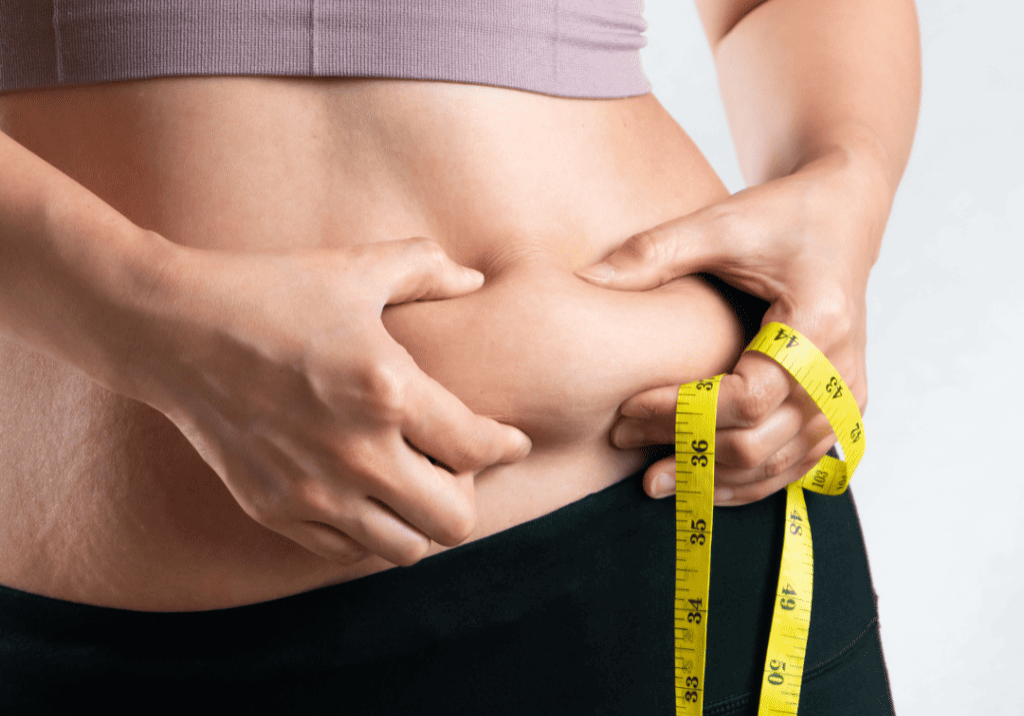Menopause is a significant stage in a woman’s life that brings about numerous changes, including hormonal fluctuations and shifts in body composition. One common concern for many women during menopause is the accumulation of belly fat.
Belly fat or gaining weight around the middle, often called a muffin top, is often considered an inevitable part of aging, especially for women as they move into midlife. It’s frustrating and depressing to wriggle into a skirt or button-up jeans that used to fit. I get it; it happened to me.
But you can do something about it
While it may seem challenging to combat this stubborn fat, there are effective strategies and lifestyle changes that can help you achieve a healthier, more balanced body. In this blog post, we will explore some valuable tips to help you get rid of belly fat during menopause.
What happens in perimenopause and menopause?
One of the most common complaints of women over forty is the sudden and unexplained weight gain around the middle. It’s almost as if the belly fat appeared overnight despite nothing else changing in terms of diet and exercise. What is happening is that body fat is being redistributed to the abdomen due to testosterone and declining estrogen, called visceral fat.
It can have serious health consequences if not addressed. Belly fat is not limited to the extra layer of padding located just under your skin (subcutaneous fat). It also includes visceral fat, deep inside your abdomen, padding your internal organs. Visceral fat increases the risk of heart disease, diabetes, and breast cancer. Fat deposited in your belly is biochemically different from fat elsewhere; it makes an inflammatory brew of bad chemicals that causes you to age faster than someone who does not.
How do you know if you have too much belly fat (besides looking in the mirror)?
Measure your waist to hip ratio.
- Use a cloth tape measure, and measure your bare stomach at about 2 or 3 inches above your navel. Pull the tape measure so that it is snug but does not push into your skin. Write this number down.
- Then measure the circumference of your hip bones using the tape measure again. Record this number.
- Divide the waist number by the circumference at your hip bones. This math yields your waist-to-hip ratio.
Here is what it means:
- 0.75-0.80 Good
- 0.80-0.85 Average
- 0.85-0.90 High
- >0.90 Too High
What’s the best way to reduce belly fat? 5 Ways
Test, Don’t Guess
The first step is to test, don’t guess. Make sure to look at your hormones and ensure there is no other issue. Get these labs done and measure your wait-to-hip ratio to understand your risk.
- Vitamin D
- hs-CRP
- Fasting insulin or HbaiC
- DHEA-S and free testosterone
- Thyroid Panel
These will help you create a personalized plan for you.
Exercise for fat loss
Exercise can help eliminate visceral fat and convert white fat to brown fat, which is metabolically better for you. A combination of cardio and resistance training 3-5 times a week is ideal. Cardio can include HIIT, running, yoga, or even hiking. The higher-intensity exercise modulates the mTOR gene and gets your body to produce more growth hormone, which helps to reduce visceral fat.
Strength training increases muscle mass which keeps the metabolism revved up, which improves the body’s ability to burn fat.
Try intermittent fasting.
This is the best way to decrease belly fat. Intermittent fasting inhibits alpha fat and cortisol receptors, reducing the body’s ability to store fat. There was a 2014 study that showed that with IF alone, patients were able to lose 4 to 7% waist circumference.
There are also emerging data to support cancer prevention and cognitive decline.
Keto-Leaning Diet
Ketones are made in the liver when there are not enough carbohydrates to be burned for energy demand, so the body turns to fat for energy. The body enters ketosis when blood sugar levels are below a certain level, and liver glycogen is no longer available to produce glucose for energy.
I find KETO is difficult for most women, so I modify this to be Keto, so I modify this to be Keto Leaning.
If you choose to go KETO, I suggest you do this for 6 months or less and then revert to a lower-carb, anti-inflammatory diet. The basics are:
- Eat fewer carbohydrates, about 10 percent of total calories (aim for 30 to 50 grams per day, and adjust to find your carb threshold)
- Increase your fiber intake to at least 25 grams or more per day.
- Consume more healthy fat, about 60 to 80 percent of total calories, mostly plant- and fish-based.
- Eat protein. Studies have shown that people who eat at least 1 – 1.5 g of protein for every kg of lean body mass have less belly fat than people who eat less.
Smart Supplements
Some essential supplements have emerged to help women through their menopause transition and visceral fat loss.
I advise supplementing with 1,000 milligrams of omega-3 (with 360 milligrams EPA and 240 milligrams DHA) taken once in the morning. Choosing a high-quality fish oil certified by the International Fish Oils Standards (IFOS) is essential, guaranteeing quality, potency, and purity.
Managing belly fat during menopause requires a holistic approach that combines a healthy diet, regular physical activity, stress management, and self-care. By making gradual lifestyle changes and adopting these strategies, you can achieve a healthier body composition and improve overall well-being during this transformative phase of life. Remember to be patient with yourself and celebrate small victories along the way.
If you’re struggling to lose belly fat despite your efforts, consider letting the team at Well Woman MD help you. We can provide personalized advice based on your specific needs, hormonal changes, and health conditions, if any.
2. E. Cereda et al., “Increased Visceral Adipose Tissue Rather Than BMI as a Risk Factor for Dementia,” Age and Ageing 36, no. 5 (2007): 488–91; D. R. Gustafson, “A Life Course of Adiposity and Dementia,” European Journal of Pharmacology 585, no. 1 (2008): 163–75; D. R. Gustafson, “Adiposity and Cognitive Decline: Underlying Mechanisms,” Journal of Alzheimer’s Disease 30, no. s2 (2012): S97–112; D. Frasca et al., “Aging, Obesity and Inflammatory Age-Related Diseases,” Frontiers in Immunology 8 (2017): 1745; R. de Mutsert et al., “Associations of Abdominal Subcutaneous and Visceral Fat with Insulin Resistance and Secretion Differ Between Men and Women: The Netherlands Epidemiology of Obesity Study,” Metabolic Syndrome and Related Disorders 16, no. 1 (2018): 54–63.
3. C. J. Ley et al., “Sex- and Menopause-Associated Changes in Body-Fat Distribution,” The American Journal of Clinical Nutrition 55, no. 5 (1992): 950–54.
4. https://doi.org/10.1186/1550-2783-7-31
5. https://doi.org/10.1089/jmf.2017.3937
6. G. A. Greendale et al., “Changes in Body Composition and Weight During the Menopause Transition,” JCI Insight 4, no. 5 (2019).





